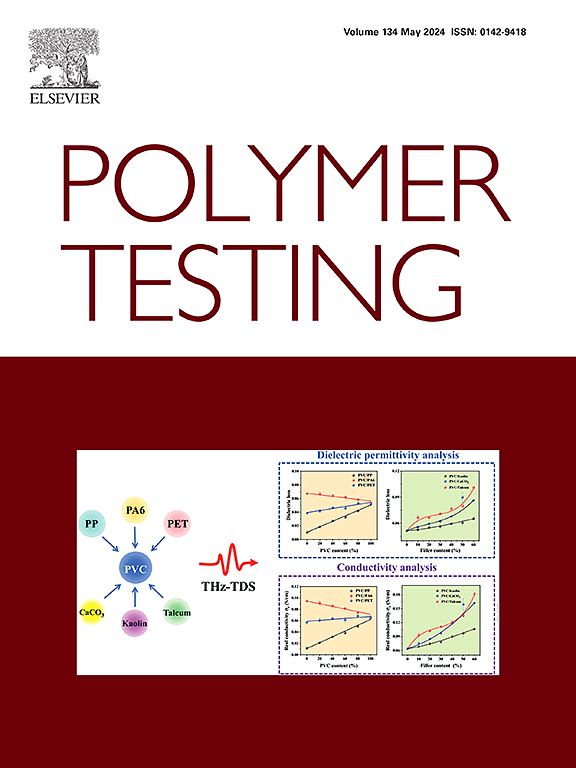Stress triaxiality and failure in SFRPs: a novel workflow for failure curve determination, considering fibre orientation and specimen geometry
IF 5
2区 材料科学
Q1 MATERIALS SCIENCE, CHARACTERIZATION & TESTING
引用次数: 0
Abstract
This research investigates the static failure behaviour of a PA6T/6I GF50, focusing on the distribution of the stress triaxiality at critical points where failure is expected. The study explores whether a relationship exists between this stress state indicator and the strain experienced by the material, providing insights into when critical failure conditions are reached. Experimental tests, including uniaxial, biaxial, bending and shear, were conducted on various specimen types and loading orientations relative to their injection moulding direction. Finite element simulations, accounting for material's anisotropic elasto-plastic response, were run to evaluate the critical local stresses at failure locations. Digital image correlation was employed throughout the test campaign to monitor strain evolution. The evolution of the stress triaxiality during loading was computed from simulation results at both the macro (composite level) and micro-scales (matrix level). At the macro scale, it was evaluated using both isotropic (von Mises) and anisotropic (Hill 48) yield models. However, neither approach successfully identified generalized failure curves, as those correlating stress triaxiality with equivalent plastic strain, applicable across all loading scenarios and specimen geometries. To overcome this limitation, a new approach based on the calculation of the stress triaxiality and equivalent plastic strain locally at critical failure points was proposed. This allowed the identification of a failure curve that is independent of loading conditions and specimen geometry, underscoring the importance of triaxiality-based material characterization over traditional uniaxial approaches for accurately predicting failure in anisotropic short fibre-reinforced polymers.
应力三轴性和SFRPs的失效:一种新的失效曲线确定工作流程,考虑纤维取向和试样几何形状
本研究调查了PA6T/6I GF50的静态破坏行为,重点关注在预期破坏的临界点处应力三轴性的分布。该研究探讨了该应力状态指标与材料所经历的应变之间是否存在关系,从而为达到临界失效条件提供了见解。针对不同的试件类型及相对于其注塑方向的加载方向进行了单轴、双轴、弯曲和剪切试验。考虑材料的各向异性弹塑性响应,进行有限元模拟,以评估破坏位置的临界局部应力。在整个测试过程中采用数字图像相关来监测应变演变。从宏观(复合材料水平)和微观(基体水平)两方面计算了加载过程中应力三轴性的演化规律。在宏观尺度上,采用各向同性(von Mises)和各向异性(Hill 48)产量模型对其进行了评估。然而,这两种方法都没有成功地确定广义破坏曲线,即将应力三轴性与等效塑性应变相关联的曲线,适用于所有加载场景和试样几何形状。为了克服这一局限性,提出了一种基于临界破坏点局部应力三轴性和等效塑性应变计算的新方法。这使得识别与加载条件和试样几何形状无关的失效曲线成为可能,强调了基于三轴的材料表征比传统的单轴方法更重要,可以准确预测各向异性短纤维增强聚合物的失效。
本文章由计算机程序翻译,如有差异,请以英文原文为准。
求助全文
约1分钟内获得全文
求助全文
来源期刊

Polymer Testing
工程技术-材料科学:表征与测试
CiteScore
10.70
自引率
5.90%
发文量
328
审稿时长
44 days
期刊介绍:
Polymer Testing focuses on the testing, analysis and characterization of polymer materials, including both synthetic and natural or biobased polymers. Novel testing methods and the testing of novel polymeric materials in bulk, solution and dispersion is covered. In addition, we welcome the submission of the testing of polymeric materials for a wide range of applications and industrial products as well as nanoscale characterization.
The scope includes but is not limited to the following main topics:
Novel testing methods and Chemical analysis
• mechanical, thermal, electrical, chemical, imaging, spectroscopy, scattering and rheology
Physical properties and behaviour of novel polymer systems
• nanoscale properties, morphology, transport properties
Degradation and recycling of polymeric materials when combined with novel testing or characterization methods
• degradation, biodegradation, ageing and fire retardancy
Modelling and Simulation work will be only considered when it is linked to new or previously published experimental results.
 求助内容:
求助内容: 应助结果提醒方式:
应助结果提醒方式:


